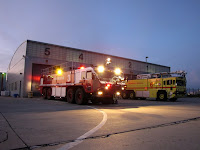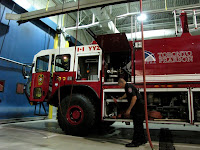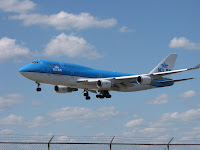Some people call it a prank, others call it mischief... but Transport Canada classifies it as a Security Concern in the same category as bomb threats, sabotage, hijacking, theft and vandalism. This type of attack is a serious threat to aviation safety, and the frequency of occurrences has been on the rise.

In the last several years, incidents of aircraft lasering have increased at an alarming rate all over the world. The graph included here shows a very simplistic view of the increase in lasering incidents in Canada from 2004 to 2010 (based on data from Civil Aviation Daily Occurrence Reporting System - CADORS).
I am but a humble aviation enthusiast who spends a lot of time at Toronto Pearson International Airport. I am also part of an organization that works with Peel Regional Police, the Greater Toronto Airport Authority, and the RCMP to improve and increase safety around the airport. My interest in aviation and airport security has driven me to write this in an effort to "spread the word" about the growing risk of aircraft lasering attacks. During the course of 2010, there were more than 40 aircraft lasering incidents at Toronto's Pearson Airport alone!
Understanding the Risks & Dangers
One of the obstacles in fighting aircraft lasering is trying to get people to understand the risk, and take the problem seriously. There are a few key points that need to be understood:
1. The lasers used in the majority of these incidents are not the little red laser pointers you use to point to slides in your presentations or to play with your cat. They are significantly more powerful and are generally green in colour. These lasers are most commonly used by astronomers to point out objects in the sky and align their telescopes. Unfortunately, some people have now started using the lasers in a negative way.
2. There are a few major safety concerns with these incidents
- distraction of the Captain and/or First Officer during a critical point of a flight, such as take-off, climb, approach and landing.
- temporary visual impairment from the light (much like looking at the headlights of an oncoming car at night and then seeing spots once it has passed).
- illumination of the cabin of the aircraft, making it very difficult to read instruments or to see outside (much like driving at night with the interior lights on in your car).
- although far less likely or frequent, temporary and even permanent damage to the eyes can occur if the distance is short enough and the laser is powerful enough.
3. Because of the nature of the incidents, they occur when an aircraft is close to the ground (i.e. take-off and landing) and at a level that allows the laser to hit the cockpit of an aircraft. These points in a flight generally carry the most risk and allow the smallest margin of error, so any distraction or interference greatly increases this risk.
What is being done about it?
If convicted of pointing a laser into an aircraft cockpit, the offender could face a $100,000 maximum fine under the Aeronautics Act, imprisonment for up to five years, or both. This is indeed a serious problem, and it needs to receive equally serious attention with equally serious consequences. Unfortunately, it does not seem to receive the attention it demands.
Only one person has been caught and convicted of aircraft lasering. Let's examine and understand the message that is being conveyed with the sentence that was given in that case:
- A person broke a law that has a maximum penalty of $100,000 and/or 5 years in prison.
- This person plead guilty to breaking this law, and the reason he gave was that he was just having some fun.
- Not only did he laser a commercial airliner, but when the police helicopter flew overhead to have a look around, he lasered them too.
- There has been a significant amount of concern about this behaviour, as well as the extremely small chance of catching the people doing it.
- The sentence that was finally given to this person was a $1,000 fine and the confiscation of his laser pointer.
He endangered the lives of dozens of people on the aircraft and who knows how many people on the ground, but $1,000 should cover it. Sounds a little ridiculous, right? Because it is ridiculous! If this is the kind of example we are making of those who break this law and endanger human life, you can expect the numbers of instances to continue to climb.
If you witness an aircraft lasering incident, report it to your local authorities with as much information as you can provide (location, time, people involved, license plate numbers, etc...).
Thank you for reading.
 In the last several years, incidents of aircraft lasering have increased at an alarming rate all over the world. The graph included here shows a very simplistic view of the increase in lasering incidents in Canada from 2004 to 2010 (based on data from Civil Aviation Daily Occurrence Reporting System - CADORS).
In the last several years, incidents of aircraft lasering have increased at an alarming rate all over the world. The graph included here shows a very simplistic view of the increase in lasering incidents in Canada from 2004 to 2010 (based on data from Civil Aviation Daily Occurrence Reporting System - CADORS).























